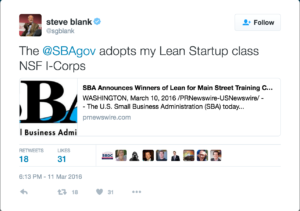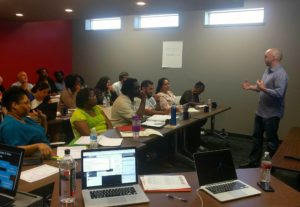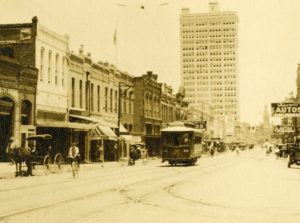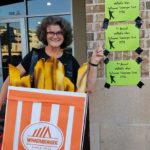By Rolando Rodriguez Soto
(This post is part of an on-going series about Downtown Waco. In a sense, Downtown is “everybody’s neighborhood.” In this series of blog posts we hope to contribute to the on-going conversation in Waco about what it takes to have a great downtown, and what we want for our own “Wacotown.” To see all the posts in this series, click here: Downtown Waco. – ABT)
Many people in Waco have begun to forgo suburban homes and apartments for a unique place in Waco we are beginning to rediscover. They have found a place that offers historical value, a lively environment and an opportunity to be a part of a new trend in downtown living. What’s it like to be a part of that trend in Waco?
I spoke with four professionals in the Waco community. They have not only found home in downtown, but also have committed their careers to take action in Waco for the benefit of the city and the great people in it.
Jorge Delgado
 Jorge Delgado grew up in south Texas and graduated from Baylor University in 2002. He is currently working with the Salvation Army to help people that are homeless, low-income families and veterans. He grew up in a county heavily populated with welfare dependent families, so he has a good understanding of how to connect with people who have fallen victim to circumstance.
Jorge Delgado grew up in south Texas and graduated from Baylor University in 2002. He is currently working with the Salvation Army to help people that are homeless, low-income families and veterans. He grew up in a county heavily populated with welfare dependent families, so he has a good understanding of how to connect with people who have fallen victim to circumstance.
After graduating from Baylor, Delgado lived in Lacy Lakeview outside of Waco for six years. Once new developments such as apartments and restaurants starting appearing in downtown, and with his job only a few blocks away, he decided to make the move. He has lived in Tinsley Place for almost three years now.
“When I graduated from Baylor, it [downtown]was still in its infancy stage,” Delgado said. “Now, when Baylor has homecoming, my former Baylor colleagues come into town, and they say, ‘This is not the same Baylor. This is not the same Waco.’”
Delgado attributes downtown’s growth to McLane Stadium and Magnolia Market. However, he fears this new need to maintain a positive image could affect nonprofits and the citizens that these nonprofits serve.
“My fear is that, with all of this growing and expanding, that the focus shifts away from trying to help lower income folks get the resources they need,” Delgado said. “For example, in downtown you have the Salvation Army, Caritas, My Brother’s Keeper, and Mission Waco,” Delgado said. “My biggest fear is that they try to push those organizations out …this is where all of those people know to come.”
Eric Martin
 Eric Martin was raised in Michigan. His educational and professional career has allowed him to visit a wide range of places including Colorado for undergraduate school, San Diego for his PhD, and his first job as a researcher in the London. He moved to Waco when he was hired as an assistant professor in Baylor’s Great Texts Program.
Eric Martin was raised in Michigan. His educational and professional career has allowed him to visit a wide range of places including Colorado for undergraduate school, San Diego for his PhD, and his first job as a researcher in the London. He moved to Waco when he was hired as an assistant professor in Baylor’s Great Texts Program.
Martin has been living in Waco for three years in an old fourplex building near Washington and 18th. With his work so close and his dedication to transit by bicycle, his daily routine revolves around downtown Waco.
“I commute between home and Baylor University along Austin Ave and 8th Street,” Martin said. “I frequent restaurants and cafes in East Waco on Elm, in North Waco near 15th Street, and of course in downtown. I love being near the Brazos River and Cameron Park.”
He noted two major issues with downtown that limit the ability for downtown Waco to truly become a livable and sustainable area—a grocery store and infrastructure for pedestrians and cyclists.
“It’s pretty crazy that we need to get on an interstate highway, or cross Valley Mills Dr. on a bicycle just to buy groceries,” Martin said. “If downtown is going to be a pleasant place to be rather than just a place to drive through, we need some investment in basics like sidewalks and bike lanes because car traffic speeds are pretty high along Franklin or Washington Avenues.”
Liz Ligawa
 Liz Ligawa lived in Waco and in the surrounding area before graduating from Baylor. She has her Master’s degree in divinity and social work. She currently works at Prosper Waco as the Director of community engagement.
Liz Ligawa lived in Waco and in the surrounding area before graduating from Baylor. She has her Master’s degree in divinity and social work. She currently works at Prosper Waco as the Director of community engagement.
A few months ago, Ligawa moved into an individual condo near the Waco Central Library on Austin Ave, across the street from the Prosper Waco office.
She said living in downtown, surrounded by business and commerce and a variety of people reminds her of the city experience she had in Atlanta. “It’s interesting to see different types of people from all walks of life with lots of interesting stories to tell,” she says.
Ligawa was never interested in a cookie cutter lifestyle. She was more drawn into a space with personality and variety. She fears that because downtown is growing so fast, it may all start to look too similar.
“Downtown needs to slow down to bring in diversity with a more intentional approach”, Ligawa says. “If you want to go far you have to go slow with more Wacoans insight. It needs a good mix,” she continued.
Unlike Eric Martin, Ligawa doesn’t see a great need for a grocery store in downtown just yet, because there are other places in Waco that need one before downtown. Instead, Waco resources should be put into creating a more walkable space, getting more residents and businesses in the area and creating a diverse space for people of all different age groups rather than one demographic.
Ligawa’s main priority for downtown would be creating more sitting areas in downtown. “There needs to be physical investments to encourage people to hang out with sitting areas that invite people to be together outdoors”, Ligawa says.
Cuevas Peacock
 Cuevas Peacock hails from Port Arthur, Texas. His work with AmeriCorps and City Center Waco led him to downtown Waco where he currently lives in a loft in the Austin Arms building.
Cuevas Peacock hails from Port Arthur, Texas. His work with AmeriCorps and City Center Waco led him to downtown Waco where he currently lives in a loft in the Austin Arms building.
He is planning on moving out of the Austin Arms soon because of planned renovations, and he is considering the Waco High Lofts because he wants to stay in the downtown area.
Peacock originally moved into downtown because it is affordable in comparison to living in Austin. He enjoys the energy of the people and attractions in the urban environment, and he wanted to be a part of the movement that is pushing new developments in downtown.
Similar to Jorge Delgado and Eric Martin, Peacock said downtown needs a grocery store. More importantly, however, as each person mentioned before him, downtown needs more sidewalks to encourage people to walk around.
“Downtown needs more ‘placemaking’ items,” Peacock said. “For example, there is a street in downtown Dallas and when you look to the left, there is a big eyeball, just looking at you. Waco needs things like that to make walking in downtown Waco more interesting.”
Walking from Austin Arms to the downtown hub is empty and “a big ugly,” Peacock said. Waco needs ways to connect the various areas of downtown with “placemaking” items or initiatives.
Conclusion
I am graduating from Baylor this weekend, so I will soon be in a place where I can start searching for a place that will become my first home where I can cultivate my career and adulthood.
Through these conversations, I got a broader understanding of what it means to live in downtown. Downtown isn’t perfect yet, but that isn’t the point. Downtown is a great central environment with potential to become amazing in a few years. It only takes people like Jorge, Eric, Liz and Cuevas that are willing to make the first step.
When I asked what advice they would give to someone considering living in downtown, Cuevas said it best. “Do it.”
 Rolando Rodriguez Soto was raised in Waco, TX, and he is currently attending Baylor University with plans to graduate in December 2016 with a Bachelor of Arts in Professional Writing & Rhetoric. After graduation, he hopes to work in Waco in the nonprofit sector to help realize the full potential of Waco. His long term goals include hopefully creating and publishing creative work whether that is a novel, short story or even a television show.
Rolando Rodriguez Soto was raised in Waco, TX, and he is currently attending Baylor University with plans to graduate in December 2016 with a Bachelor of Arts in Professional Writing & Rhetoric. After graduation, he hopes to work in Waco in the nonprofit sector to help realize the full potential of Waco. His long term goals include hopefully creating and publishing creative work whether that is a novel, short story or even a television show.
The Act Locally Waco blog publishes posts with a connection to these Aspirations for Waco. If you are interested in writing for the Act Locally Waco Blog, please email [email protected] for more information.
By Kodie Talley
“All behaviors come from underlying desires and changing the root cause of that behavior could have more affect.” – Anne Hsu, a Behavioral Scientist at Queen Mary’s University of London.
Chocolate. Cookies. Brownies. I crave all the yummy creamy delights with ice cream on top! For a while I was eating ice cream every single night…sometimes even in replacement of dinner. I’m not kidding. I thought that since I spent an hour at the gym it wouldn’t matter. And then I wondered why I wasn’t seeing progress on my weight and health goals!
As a fitness coach and health advocate, I hear from a lot of people who get discouraged because they work so hard and yet they aren’t seeing the results they envision. It’s difficult to desire progress and use it as your motivation each day only to feel you have not improved months later.
Well, something many of these people have in common is submitting to their cravings. Even if it’s not every day it can still make an impact on your progress. Oftentimes, people will eat clean for 5 days and allow the weekends to be a free for all with alcohol and all the foods they restricted during the week (pizza, burgers, ice cream). Even if you’re eating clean most of the time, all the garbage you’re allowing two days of the week is going to set you back.
Many people try to take an 80/20 approach to their diet. This means that 80% of the time they eat clean, and 20% of the time they give in to their food cravings. But what people don’t understand is that the 20% doesn’t mean 2 days out of the week you can just eat whatever your heart desires all day long. In my opinion, what 80/20 really means is Saturday you allow yourself the bowl of ice cream (but let’s not go crazy, only have 1 serving (3/4 cup)). And then maybe Wednesday you treat yourself to a dinner out. Another example is, if you have a wedding or a dinner party, or some social event, you can eat the food! Use that as your 20%, just plan ahead.
Personally, I follow a 90/10 approach to my diet. This means 10% of the time I give in to my cravings. It’s typically about 1 weekend a month and it usually falls on some holiday or monthly celebration.
Here are a few ways to get rid of your food cravings to stay strong during your 80%:
1) Distract yourself – The theory is that cravings are caused by your imagination – imagining how good that ice cream is going to taste. According to some recent research by Anne Hsu, a Behavioural Scientist at Queen Mary’s University of London, “If you hijack that part of the brain [that is imagining the food] then it can’t sustain the craving anymore. ” In her research she used an app to get people to imagine something different – a forest, or a white horse, for example – when they felt a craving. The results showed significant reductions in unhealthy snacking. A different study recently showed that the computer game Tetris, if played for just three minutes, can weaken cravings for food.
3) Find alternatives – Try grapefruit, small red baked potatoes, carrots, and salads filled with greens and fiber. These foods work by filling people up quickly, but they all work by buying time, particularly the grapefruit as the slow, strategic method of eating one can lead to a craving forgotten. This is according to Mary Beth Sodus, a Nutritional Therapist and Registered Dietician at the University of Maryland Medical Center.
4) Be Mindful – When you try these alternatives be MINDFUL about it. I’d advise, if you’re craving ice cream, eat something that has the same texture as ice cream, maybe some healthy yogurt (you could even freeze the yogurt). While you’re eating this alternative close your eyes and feel the food on your tongue. Let your taste buds savor it.
5) Attack the root cause – Think about why you’re craving this food item. Is it because you just finished dinner and you want dessert? Maybe you’re an emotional eater and something’s bothering you. Or quite possibly you’re just bored. Be mindful of the root of your cravings and maybe you can change something about the underlying cause.
 Kodie Talley graduated from the University of Idaho with a B.S. in Exercise Science and Health and a minor in International Studies. She hopes to use her degree to pursue a career in Fitness Entrepreneurship and travel abroad to serve underprivileged communities. Kodie is originally from Washington State and moved to Waco in May 2016 to intern at the Health District and live with her significant other who is attending Baylor for his masters. So far she is loving Texas and how welcoming the Waco community has been!
Kodie Talley graduated from the University of Idaho with a B.S. in Exercise Science and Health and a minor in International Studies. She hopes to use her degree to pursue a career in Fitness Entrepreneurship and travel abroad to serve underprivileged communities. Kodie is originally from Washington State and moved to Waco in May 2016 to intern at the Health District and live with her significant other who is attending Baylor for his masters. So far she is loving Texas and how welcoming the Waco community has been!
The Act Locally Waco blog publishes posts with a connection to these aspirations for Waco. If you are interested in writing for the Act Locally Waco Blog, please email [email protected] for more information.
By Salley Schmid
Stress management is a topic that can go in many different directions. All very useful and important directions in which to explore stress management. In today’s Act Locally Waco Mental Health blog, I am going to turn your attention to stress management during the holidays with regard to relationships and traditions.
There are some easier to implement stress management tips around these topics and there are some not so easy to implement, but powerfully transformative stress management tips. Here are a few of hopefully easier to implement ideas:
- Live / spend / gift within your means shame free
- Say no to make room for yes:
- pick fewer traditions, events, and travel scenarios
- Delegate or purchase pre-prepared when you can (not everything has to be homemade, give yourself a break)
- Decide as a family what are the few most important traditions and values to express during the holidays and endeavor to meet those and if nothing else gets done it’s ok
- Recruit help with anything you can – even if you need to pay for some of the help – everyone needs to earn a living and your mental, emotional health is important enough to invest in, hence paying for the help to be less burdened.
AAANNND for some that may be hard in the short run, but stress relieving and energy saving in the long run: Practice healthy boundaries in relationships. For example, when giving gifts that are within your financial means remember:
- your gifts do not define you
- others’ responses to your gifts do not define you
- your values and alignment with your values is what defines you – your heart’s intention.
Letting go of feeling responsible for how others feel and think is an act of setting a healthy boundary. The mindset of the above 3 points helps you do this letting go in order to live that healthy boundary.
Anticipation of the perfect holiday experience is a bit of a set up. That’s a tall order to fill. It is basically putting the holiday on a very high pedestal and it is a long fall from that pedestal. One detail is off and the whole experience seems tainted. Letting go of these high expectations and the anticipation of the perfect experience, makes room for flexibility, mistakes, forgiveness, and adaptability. It paves the way for resilience and peace.
Discuss what roles people can play in the holiday experience – give people jobs. Most individuals want to feel like they are making a meaningful contribution, not solely a recipient of your service. Having a role or job equals feeling useful and meaningful, not having a role or job equals feeling like a burden and useless. Invite everyone to feel useful and meaningful this holiday season.
If you have new family members – such as by marriage, invite the new members to share a tradition of their own with your family, get the details so that you can accommodate. With a heart of gratitude, give up something of your own if necessary to make room for the new.
Be flexible. As families grow dynamics of all sorts change. Maybe a different calendar date needs to be set aside for a holiday to get everyone together. The togetherness is what is important, not the number on a calendar.
Set boundaries in advance with behaviors or scenarios that have led to resentment or difficulty in the past. For example, if you have a family member who typically gets hammered at the holidays and ends up creating a difficult scenario, in advance, invite that person to come sober and stay sober so that you can connect with that person rather than connecting with alcohol. Invite them to refrain from coming if they don’t want to remain sober. Let them know if they come and end up intoxicated, you will call for a ride for them and assist them in getting home without driving.
Another example is with pets. If your holiday guests have in the past been known to bring their pets without getting permission or even knowing that they are unwelcome, in advance, set the boundary with them. Ask them to make alternative arrangements for the pets, to bring crates, or stay at a pet friendly hotel . . . and express your gratitude for their presence without the pets.
Boundaries are not easy to set. When setting them, others will not always receive them well, might accuse you of being mean or selfish, and might get mad at you. All of these responses are possible but not an indicator that you are in the wrong. It is not your job to ensure everyone is pleased with your every move. That is an impossible feat. In the long run, setting healthy boundaries reduces stress, even if it might take a bit of time to get there. However, it is less stressful than year after year dreading and then resentfully enduring the intolerable.
I wish you peace and joy this holiday season, hold on to what matters, relationships and love, not things, not food, not perfection. Embrace life and family in all of its glorious messiness. Hope for the best, but don’t expect it. Rather, let the days unfold without trying to overly orchestrate each moment and experience. Organically occurring memories will be the most meaningful. Orchestrated moments tend to carry the memory of the stress they caused trying to orchestrate them. Let peace and joy be the theme.
 Salley Schmid’s counseling practice specializes in helping people transition to a place of strength after experiencing any form of interpersonal trauma or pain, dissatisfaction in relationships, the loss of a sense of self. I work with individuals, families and parents from a family systems perspective. I have extensive experience working with individuals who have experienced psychological or emotional or sexual abuse or any interpersonal trauma, traumatic grief, divorce, blended family work, parenting challenges and attachment difficulties. Salley Schmid, LMFT can be contacted at Enrichment Counseling at: 254-235-3500 or [email protected].
Salley Schmid’s counseling practice specializes in helping people transition to a place of strength after experiencing any form of interpersonal trauma or pain, dissatisfaction in relationships, the loss of a sense of self. I work with individuals, families and parents from a family systems perspective. I have extensive experience working with individuals who have experienced psychological or emotional or sexual abuse or any interpersonal trauma, traumatic grief, divorce, blended family work, parenting challenges and attachment difficulties. Salley Schmid, LMFT can be contacted at Enrichment Counseling at: 254-235-3500 or [email protected].
(This article is about applying lean startup methods to Main Street or traditional small businesses and features McLennan Small Business Development Center’s involvement in the SBA’s Lean for Main Street Training Challenge. McLennan SBDC is now scaling its pilot regionally and offering the next Introduction to Customer Discovery cohort at the Addison TreeHouse, in Addison, Texas, from January 10 – 31, 2017. For more information and to apply, click here.)
By Jane Herndon
Too often, entrepreneurs fall in love with their invention or business idea and assume everyone else will love it, too.
Full of confidence, they dive immediately into execution with little afterthought. They make a significant up-front investment in a brick-and-mortar location, buy equipment, hire staff and open their doors. Ready, set, go!
Some might even approach it more thoughtfully and actually write a traditional business plan. Legal structure? Check. Marketing plan? Check. Financial projections? Check.
Though very different approaches, both focus on the tactical “can I build this product or business?” versus the strategic “should I build it?” But what if you build something nobody wants?
More businesses fail from lack of customers than from lack of capital or marketing or product failure. Only half of all establishments survive five years or longer. (1)
Get Out of the Building
 To address uncertainty and improve the odds of business success, Steve Blank, serial entrepreneur and father of the Lean Startup movement, and his protégé, Eric Ries, have pioneered an evidence-based approach to entrepreneurship. What the scientific method did for accelerating scientific breakthroughs, lean startup promises to do for business innovation.
To address uncertainty and improve the odds of business success, Steve Blank, serial entrepreneur and father of the Lean Startup movement, and his protégé, Eric Ries, have pioneered an evidence-based approach to entrepreneurship. What the scientific method did for accelerating scientific breakthroughs, lean startup promises to do for business innovation.
And it does so by turning the decades-old formula for writing a business plan on its head. Instead of diving in and/or launching one’s company with a business plan full of unproven assumptions (guesses), it urges entrepreneurs to “get out of the building” and in front of a volume of prospective customers to gain first-hand insight into their problems, needs and motivations. This customer-centric approach emphasizes rapid experimentation over elaborate planning, stakeholder feedback (facts) over guesswork, and placing “small bets” over big, up-front investment. It addresses the question: “is this a business worth pursuing?”
Today Blank’s lean startup class is the world’s leading pre-accelerator program. It is also the core curriculum of the National Science Foundation’s (NSF) Innovation Corps, known as I-Corps™, the nation’s premier, federally funded entrepreneurship program. The NSF uses lean to help scientists commercialize or turn their ideas into businesses.
Last year, President Obama announced plans to scale up the National Science Foundation I-Corps program with new and expanded Federal agency partnerships, the U.S. Small Business Administration (SBA) among them. McLennan Small Business Development Center is honored to participate in the first wave of the SBA’s I-Corp-inspired innovation effort.
Everybody Has a Plan Until They Get Punched in the Mouth
The first piece of advice most would-be entrepreneurs get is “go write a business plan.” And it’s true if you need a bank loan. It’s also true that few business plans survive first contact with customers. Or, as Mike Tyson once said about his opponents’ prefight strategies: “Everybody has a plan until they get punched in the mouth.”
Unlike web startups, brick-and-mortar businesses require considerable up-front financial investment just to open their doors – a time when uncertainty is highest. Creating business plans and financial models based on secondary research and guesses – without testing these assumptions first – can waste valuable time, lead to over-investing and create a false sense of security. The better up-front investment is to do some reality checks with stakeholders to find out “you don’t know what you don’t know” and whether you’re even solving a real need.
Finally, small business owners, and the people who love them, have a lot of skin in the game. The majority bootstraps their companies with their own funds or those of friends and family. According to the SBA site referenced earlier, the most common source of capital used to finance small business startup and expansion is personal or family savings (21.9%), followed by business profits and loans (5.7%). Simply put, when small businesses succeed, communities thrive. When small businesses “get punched in the mouth” and fail, families, communities and local economies suffer.
Lean for Main Street Pilot
While lean resources and programs are commonly available online and through accelerators, universities and events like Startup Weekend, they’ve been geared to tech startups. Small business owners and first-time entrepreneurs may be less aware of lean methods and more importantly, how to effectively apply them.
To this end, the U.S. Small Business Administration’s (SBA) Office of Entrepreneurial Development created the Lean for Main Street Training Challenge to bring the benefits of lean methodology to traditional “Main Street” businesses. The purpose of the challenge is to develop and pilot a variety of lean innovation curricula for small businesses and scale these teaching innovations to a wider audience. In January, they conducted their own lean experiment with the national SBA resource partner network by launching the prize competition on the federal government’s open innovation platform, Challenge.gov.
 In March, five winners were announced nationwide, including McLennan SBDC. Three weeks after the award announcement, Strategist Chris McGowan and I joined the other prize winners from San Francisco, metropolitan DC, Pittsburgh, and Mississippi to observe a national I-Corps program in Washington, DC for a 6-week train-the-trainer program.
In March, five winners were announced nationwide, including McLennan SBDC. Three weeks after the award announcement, Strategist Chris McGowan and I joined the other prize winners from San Francisco, metropolitan DC, Pittsburgh, and Mississippi to observe a national I-Corps program in Washington, DC for a 6-week train-the-trainer program.
After additional mentorship from Max Green, national I-Corps instructor based in Austin, we launched the Introduction to Customer Discovery short course (aka Customer Discovery Workshop) in August. We sought to include entrepreneurs and social innovators not typically exposed to lean startup methods and cohort-based learning. Applicants were encouraged to apply as 2-3 member teams; we selected a group of 8 teams, called a cohort. The majority of teams were women- and minority-led.
The Introduction to Customer Discovery short course is designed to help pre-venture, startup and early-stage companies establish product-market fit and improve their odds of success. Ideal candidates are those who either have an idea for an innovative new business or who’ve recently started a promising business, but aren’t getting the customer traction they anticipated.
We use a “flipped classroom” approach. All coursework is done prior to class to allow for participant-led presentations, inquiry and direct feedback from instructors. On the opening day, teams present their initial business thesis and assumptions about customer segments and value propositions. They are tasked with interviewing 10 or more potential customers every week to determine whether what they’re offering solves a real market need.
While the class runs over a three-week period, participants attend only two days of classes – the opening and closing workshop. This means, that after the opening workshop, teams “get out of the building” and work on their own schedule, talking to potential customers about their business problems and needs. Team members record their interview findings online and check in remotely with instructors via webinar for another round of instructor feedback at the halfway point. The group reconvenes on the final day where they present their findings, next steps and “lessons learned.”
Since we have limited time, instructors will push, challenge, and question in order to accelerate insight and learning cycles. Exchanges are direct, open, and tough. This approach may seem harsh or abrupt, but teaches how to challenge your own thinking and bias, and appreciate that as a business owner, you will need to learn and evolve faster than ever imagined.
Finding out if your product/service is a business opportunity worthy of pursuit – based on a volume of customer feedback – is considered “success.”
A McLennan SBDC client sums up their short course experience this way:
“This was a tectonic shift in our approach and understanding of what we have to do to succeed… The combination of the lean startup content from Steve Blank, etc., plus the brutally honest & challenging feedback is really powerful…it’s in a league of its own…”
Takeaways
- Unanticipated “punches in the mouth” can and will impact your business plan. The lean approach helps manage this uncertainty with an evidence-based, customer-centric approach to entrepreneurship.
- Small businesses are a creative entrepreneurial force and the backbone of our economy. Lean methods can catalyze economic growth and innovation by helping ventures launch more quickly, cheaply and with less risk.
- An entrepreneurial development program is only as good as the number of people it can reach. Successful ecosystem partnerships are key to taking lean innovation mainstream.
 Jane Herndon grew up as a child laborer in the family business and was bitten by the entrepreneurship bug early. A technology industry veteran, she retired from a glamorous business-modeling career to work with the SBDC. When not serving as a business mentor, she can be found down the rabbit hole with Buckminster Fuller, her rescue rabbit. For bona fides, see LinkedIn. Contact Jane at [email protected], if your organization is interesting in partnering to bring lean startup methods to local entrepreneurs and innovators.
Jane Herndon grew up as a child laborer in the family business and was bitten by the entrepreneurship bug early. A technology industry veteran, she retired from a glamorous business-modeling career to work with the SBDC. When not serving as a business mentor, she can be found down the rabbit hole with Buckminster Fuller, her rescue rabbit. For bona fides, see LinkedIn. Contact Jane at [email protected], if your organization is interesting in partnering to bring lean startup methods to local entrepreneurs and innovators.
The Act Locally Waco blog publishes posts with a connection to these aspirations for Waco. If you are interested in writing for the Act Locally Waco Blog, please email [email protected] for more information.
Notes:
(1) U.S. Small Business Administration, Office of Advocacy, Frequently Asked Questions, https://www.sba.gov/sites/default/files/advocacy/SB-FAQ-2016_WEB.pdf (2016)
By Eric Martin
Most people don’t enjoy their drives to work. In surveys, Texans rank commuting dead last in our preferences among daily activities. That’s not surprising: driving is frustrating and remarkably bad for our health, causing sleep loss, backaches, and higher blood pressure. It’s also bad for our social and personal lives: long commutes have been associated with loneliness and higher divorce rates [1].
Although we dislike long commutes, and we know they’re bad for our health, our commutes keep on growing, and the average American now spends 52 minutes a day just getting to and from work. That’s an astonishing waste of time and potential. More time in cars means less time invested in family, friends, or pursuits that matter to us.
Thankfully, most Wacoans don’t need to endure such long commutes, but we’ve followed the same trends as the rest of the country, living farther from places of work and so spending more of our time in cars.
We sacrifice that quality time because we think its loss will be made up for by other benefits. Sometimes, it’s a larger house in the suburbs. At other times, it’s the larger paycheck from a new job farther from home. But it turns out that those advantages do not outweigh the downsides of spending our lives in cars: on the whole, people report they are less happy when they accept longer commutes.
This trade-off of is so well known that researchers even have a name for it: “the commuting paradox” [2]. It seems paradoxical because we willingly make a trade-off that decreases our own wellbeing. We overestimate the benefits of bigger houses and paychecks, and underestimate the downsides of long commutes and loss of community.
Higher income and larger houses do make us happy, but only for a while. We quickly adapt to them, and then they stop conferring much happiness. Curiously, we don’t adapt to social isolation. It turns out, we are often wrong about what will make us happy.

Photo courtesy of the Texas Collection, Baylor University
Driving wasn’t always our preferred option for getting around town. In the past, Wacoans commuted by other methods: we walked, biked, and took streetcars to get around town. In central Texas, the Interurban Railway got Wacoans through town and connected us with McKinney, Denison, and Dallas. An incredible 819,000 passengers used this system at its peak in 1920 [3].
Single-passenger vehicle driving only became our dominant mode of transportation when Texans left cities for the suburbs in the 1950s, 60s, and 70s. The history of our car driving is strongly connected with the history of our flight from cities. (I have previously written about the destructive effects of “white flight” in Waco here.)

Photo courtesy of the Texas Collection, Baylor University
But there is an attractive alternative to such trends – an alternative which might encourage us to think about living in closer proximity to our places of work, school, and shopping: the trusty bicycle!
Bicycle commuting just makes sense in Waco. We already benefit from wide roads with plenty of space for multiple user groups, and we also enjoy good weather for most of the year. Additionally, the city plans to invest in more bike lanes that will help connect residential areas with employment and economic centers.
For me, getting to and from work isn’t the worst part of my day; it’s often one of the best parts. Here are a few of the tangible ways that cycling around Waco improves my own quality of life:
+ Cycling gets me places faster. This may seem counter-intuitive, but given that about half of all our car trips are within 3 miles of home, you’d be surprised how fast the journey can be on a bike. When I subtract the time I would have spent parking, most of these shorter trips are actually faster on a bike than in a car.
+ Cycling saves me money. Between gas, oil changes, and repair, driving a car is expensive. City driving is especially hard on cars and requires regular maintenance. Bicycles are cheap by comparison, costing less than public transit and far less than cars.
+ Cycling is free exercise. I feel more energetic and healthy when I get even a few minutes of physical activity every day. No need for that pricey gym membership when you’re getting around town by bike.
+ Cycling supports our local economy. I’m happy when my money stays in Waco rather than going to corporate offices in some faraway city. Local economies flourish when more people are walking and cycling compared with driving [4].
+ Cycling doesn’t pollute the air. About 600,000 children in Texas have asthma, and over 500 of them are hospitalized each year on account of it [4]. We know that pollutants from our cars cause asthma and other respiratory diseases. If Wacoans want to “love one another,” then we must ask how our own behavior affects our neighbors’ wellbeing.
+ Cycling is simply an elegant way to travel. I’m dependent only on a simple machine, and I feel free while using it. Cycling connects me with parts of my environment that I’m otherwise isolated from: the city’s topography, the weather, and the people in my community.
What about safety? Isn’t cycling dangerous? It’s true that being on the roads with cars takes some practice and caution. And our city can help make cycling safer with better infrastructure such as bike lanes. But that said, cycling may not be as dangerous as you think. Recall that the exercise from cycling imparts substantial health benefits and decreases risk from the leading causes of death.

Photo courtesy of the Texas Collection, Baylor University
While automobiles clearly have their uses, by and large, they haven’t made Americans happier, and they often make us less happy. That could prompt you to try something new. More and more Americans are commuting by bicycle. You might be surprised to rediscover how fun it can be.
 Eric Martin is an Assistant Professor of History & Philosophy of Science at Baylor University’s Great Texts Program. When he’s not at work, he can be found riding his bicycle, exploring Cameron Park, or enjoying coffee.
Eric Martin is an Assistant Professor of History & Philosophy of Science at Baylor University’s Great Texts Program. When he’s not at work, he can be found riding his bicycle, exploring Cameron Park, or enjoying coffee.
The Act Locally Waco blog publishes posts with a connection to these aspirations for Waco. If you are interested in writing for the Act Locally Waco Blog, please email [email protected] for more information.
Notes:
[1] See Daniel Kahneman and Alan B. Krueger. 2006. “Developments in the Measurement of Subjective Well-Being” Journal of Economic Perspectives 20:1 3–24; Robert D. Putnam. 2000. Bowling Alone: the Collapse and Revival of American Community. New York: Simon & Schuster; Erica Sandow. 2014. “Til Work Do Us Part: The Social Fallacy of Long-distance Commuting” Urban Studies 51:3 526-543.
[2] Alois Stutzer and Bruno S. Frey. 2004. “Stress That Doesn’t Pay: The Commuting Paradox” IEW – Working Papers 151, Institute for Empirical Research in Economics, University of Zurich.
[3] Terri Jo Ryan, “Interurban Railway,” Waco History, accessed November 26, 2016, http://wacohistory.org/items/show/117.
[4] Tanya Snyder, “Bicycling Means Business: How Cycling Enriches People and Cities,” StreetsBlog USA, accessed November 26, 2016, http://usa.streetsblog.org/2013/03/08/bicycling-means-business-how-cycling-enriches-people-and-cities/
[5] http://www.cdc.gov/asthma/stateprofiles/asthma_in_tx.pdf
By Ellen Filgo
The Waco Diaper Bank has been around for a whole year! For those of you who haven’t heard of us yet, the Waco Diaper Bank is dedicated to providing diapers to Waco and McLennan County families in need. This past year we distributed over 35,000 diapers – that’s over 4000 little bottoms dry for a day. Last year, when the organization launched, I wrote about why it’s so important that babies and toddlers have access to a supply of clean diapers: without them, there are not only health risks, but there are barriers to childcare and lost days at work and school for parents. State and federal assistance programs don’t provide diapers. The cost of diapers is high, at roughly $80-$100 a month per child.
A few months ago, I attended the Diaper Banks in America conference, put on by the National Diaper Bank Network (of which the Waco Diaper Bank has just become a member). While there I heard many stories from people around the country who have started diaper banks in their local communities, prompted by the startling statistic that 1 in 3 families in America struggle to afford diapers. Being a part of a newer, smaller organization, it was great to hear from more established diaper banks about how they operate, what their budgets look like, how they apply for grants, about the types of programs they provide, the agencies they work with, how they market their message, mobilize their networks, etc. The conference gave me a ton of information to help grow the Waco Diaper Bank and serve more families in our community.
While giving diapers to families in need helps in the short term, diaper need is a larger problem. So while at the conference, we also heard from a California state representative, Lorena Gonzalez, who co-sponsored, with bipartisan support, a bill to eliminate the sales tax on disposable diapers. While it passed in the California Senate, it unfortunately met with a veto on the Governor’s desk. Nevertheless, she is vowing to continue the fight to support families in need. After her talk, I was eager to partner with other diaper bank leaders in Texas. Together, I hope to find sympathetic legislators who will address this issue here in Texas.
In the coming year, I hope the Waco Diaper Bank can serve the community by providing diapers and by advocating for larger changes. That’s how I would love for the Waco Diaper Bank to progress over this next year. If you would like to be involved, please contact me at [email protected].
One way to help out this December is to be involved with our 2nd annual December Diaper Drive. From December 1-14, we will be collecting diapers at locations around Waco. Last year the Waco community outdid itself in generosity, collecting over 28,000 diapers. Can we beat that number this year? I would love for you to help us reach that goal.
There are other ways to help as well! Are you planning on throwing a holiday party? Ask your guests to bring a package of diapers. Are you doing some online Christmas shopping? Consider our gift-in-kind wishlist. Are you evaluating your year-end giving? You can donate online to help the Waco Diaper Bank with the acquisition and distribution of diapers.
Waco has a lot of need, but Waco also has a lot of heart. Together, we can help babies and toddlers in our community.
 Ellen Filgo is a research librarian at Baylor and a Wacoan of 8.5 years. She loves living in Sanger-Heights with her husband, her stepson and her two energetic little boys. She has been known to get sidetracked researching the answer to a random question casually asked in a Facebook post.
Ellen Filgo is a research librarian at Baylor and a Wacoan of 8.5 years. She loves living in Sanger-Heights with her husband, her stepson and her two energetic little boys. She has been known to get sidetracked researching the answer to a random question casually asked in a Facebook post.
The Act Locally Waco blog publishes posts with a connection to these aspirations for Waco. If you are interested in writing for the Act Locally Waco Blog, please email [email protected] for more information.
(Note: This post is part of an on-going series on financial literacy. Two of the goals of Prosper Waco have to do with accumulating wealth: (1) Reduce the percentage of Waco-area households living without three months’ worth of savings if they were not able to work. (2) More than 50 percent of Waco households will have a net worth above $15,000. Our hope is that this series will help move our community towards accomplishing these goals both by sharing information about some of the challenges, complexities and practicalities of managing finances. For other posts in this series, click here: Financial Freedom. — ABT)
By Phil Oliver
Welcome to undoubtedly the most generous, unplanned, impulsive time of spending in America—–Thanksgiving and Christmas!!
These wonderful times encourage us to give and spend freely on the ones we love and causes we passionately care about.
So, how do YOU plan to balance the WANT to give with the healthy ABILITY to give without growing debt that will last long into next year? This is the question that many families and individuals struggle with as they face ever tightening budgetary situations.
I addressed the main component of this desire in my very first blog about motivation. Refuse to give in to the ever increasing pattern of proving and buying love with stuff, but rather deepen and extend love with time, involvement and more stress-free planned giving/spending. Each family and individual can have a WONDERFUL giving experience as they realistically plan for the stuff and then intentionally budget their time for more longer-lasting relational investing.
First, the Christmas gift giving season demands advanced planning. Luckily, it happens each year at the same time, so it can be expected and anticipated. Ideally, each family would have a little savings set aside every month for gifts and celebrations that would include a large portion for Christmas– gift giving, travel, food, and decorations.
The reality for most is that this doesn’t happen. As the holidays approach the excitement (and tension) grows for the individual gift purchases and with it the expectations to show love and appreciation with stuff.
What to do?
- If you haven’t yet set a Christmas spending plan, do it NOW!!
- Determine ALL the people, agencies, organizations and ministries that you plan to give to and prioritize.
- Determine closely and reasonably how much money you have available to spend. This could be from your current savings, extra work, or even spending less on yourself.
- Let your entire household help decide on any spending outside your direct family. DON’T BORROW ON ANY ANTICIPATED IRS REFUND!!
- Write down the individual people and organizations and divide the money you currently have to give to each. Then, you can also include an additional percentage of any extra money that comes in before the gift is given. You would probably want that to be for close family members.
- Use your listed amounts and look/search online and sales for items that you and your family want to purchase for the best deals. Also, consider gently used items that are more budget friendly.
- Commit as a family to follow your budget without borrowing or going into more debt. Involve even the youngest in the process–make it a game and be creative together!
- Plan for shared shopping, buying, and wrapping. It then becomes an exciting, shared giving experience/memory.
Here are some great apps that may also help in planning:
- EveryDollar (free for Android and iOS) — Christmas and all year
- Santa’s Bag – Christmas Gift List (free) — Specifically Christmas spending
Here are some links for more ideas to help:
- “11 Tips For Holiday Shopping That Won’t Break The Bank”
- “The Christmas Budget You’ve Always Wanted”
As you and your family begin to look at areas of seasonal financial health and security, I hope some of this information will help to propel your progress to include intentional generosity in ALL your financial planning!
Finally, if you have decided you want to start a comprehensive financial plan for your family, please check out the Federal Reserve’s Free publications and web resources that have been endorsed by many of our local financial institutions as well as Prosper Waco:
Have a WONDERFUL, FINANCIALLY HEALTHY holiday season with family and friends!!
 Phil Oliver is a retired educator. He is an independent Financial Coach, active mentor, and community activist. He has spent the last 8 years empowering individuals and families to take charge of their finances through his FLOW system. He is active in many community efforts to grow financial literacy and responsibility including Prosper Waco and Citizens for Responsible Lending. He consults with many local organizations to teach and inspire their efforts to empower clients in personal finances. You can contact him at: [email protected]
Phil Oliver is a retired educator. He is an independent Financial Coach, active mentor, and community activist. He has spent the last 8 years empowering individuals and families to take charge of their finances through his FLOW system. He is active in many community efforts to grow financial literacy and responsibility including Prosper Waco and Citizens for Responsible Lending. He consults with many local organizations to teach and inspire their efforts to empower clients in personal finances. You can contact him at: [email protected]
The Act Locally Waco blog publishes posts with a connection to these aspirations for Waco. If you are interested in writing for the Act Locally Waco Blog, please email [email protected] for more information.
By Diego Loredo
It’s already the end of the semester! If you had told me at the beginning of the semester that it would be over before I knew it, I probably wouldn’t have believed you. However, the end of the semester is already here. And, all of the assignments and projects that I pushed off are finally catching up with me!
I have three group projects, one presentation, and three final exams to take. Two of those group projects are for one class and the other group project (along with the presentation) is for another class. I also have an exam on Monday, along with the final exams during the last week of the semester. Overall, I have quite a bit of work to do. It’s easy for all of your work to pile up on you during the last few weeks of the semester. So here’re a few tips on managing your work at the end of the semester, as well as a few final exam tips.
Use your time-off well
I know it’s hard to do work during a break but it’s a good idea to do it anyway. I know a lot of professors like to assign work during the Thanksgiving break so most students will be doing work anyway. Don’t do too much work during the break or you’ll burn yourself out too. But, dedicate a day or two to catch up on work or study for upcoming exams.
Keep in touch with group members
If you’re doing a group assignment, make sure to keep in touch with your group members so that all of you know what to do. Don’t be that group member who doesn’t ever reach out to the other members.
Bring textbooks with you back home
It’s easy to forget that you have work to do when you’re going back home for the break. If you have to study or have work to do, bring whatever you need that will help (textbooks, notes, etc.). Make sure to have what you need so that you won’t have to drive all the way back or blow off the assignment.
Keep track of your exam schedule
Mark on your calendar when and where your exams will be. I have a friend who missed an exam because he didn’t check the syllabus right and went to class during the wrong time and missed the exam, ultimately failing the class. Make sure ahead of time that you know when your exams are, so that you don’t risk missing them.
I know how difficult the last few weeks of the semester can be. I’m taking a senior level class and all of the seniors there are stressing over the final project. I’m still a junior but I’m still stressing out just as much if not more than them. I tried to come up with these tips based on my personal experience and hopefully they can help other students who are preparing for finals or projects. Good luck! Finish strong!
 Diego Loredo is a junior at the University of North Texas and is majoring in public relations. He is a scholarship recipient of the Brazos Education Foundation, otherwise known as “Brazos Scholars.” He graduated from University High School in 2014. He plans on working in sports PR or for a nonprofit. He loves to play soccer and is a huge FC Dallas fan. Have something that you would like Diego to write about or have a problem that you would like to ask him? Shoot him an email at [email protected].
Diego Loredo is a junior at the University of North Texas and is majoring in public relations. He is a scholarship recipient of the Brazos Education Foundation, otherwise known as “Brazos Scholars.” He graduated from University High School in 2014. He plans on working in sports PR or for a nonprofit. He loves to play soccer and is a huge FC Dallas fan. Have something that you would like Diego to write about or have a problem that you would like to ask him? Shoot him an email at [email protected].
The Act Locally Waco blog publishes posts with a connection to these aspirations for Waco. If you are interested in writing for the Act Locally Waco Blog, please email [email protected] for more information.
By Alan Northcutt
Solar panels, also called photovoltaic cells, were installed on my roof around New Year’s Day 2016. Since that time my average electricity bill has been $3.13. In fact, for 3 of those months my bill was $0.00. Yes, $0.00. So I would like to share my amazing experience with solar energy through a practical overview applicable to Central Texas.
Cost. Although the exact price of a home solar system depends on multiple variables, I will provide a general example for illustration. Importantly, now is an excellent time to go solar in light of plummeting panel prices and available incentives. A 7.5kW system (producing about 850kWh per month) has an invoice price of approximately $25,000. If the home is within their service area, ONCOR’s generous incentive would lower the purchase price to $20,000. And at income tax time, the 30% federal tax credit of $6000 would further lower the final price to only $14,000. The average time to pay for a system with electric bill savings is 7 to 8 years. After that, the system generates income, through these lower or absent electric bills.
Obstacles. The primary requirement is that the roof be unobstructed by trees or other objects. (But if an obstruction exists, many installers erect ground based solar arrays in the customer’s backyard.) A south facing roof generates maximum energy, but is not mandatory. Finally, homeowners’ associations will often assert that rooftop solar is not allowed. Fortunately, this claim is false, and these associations are not able to restrict solar installations in Texas. In reality, solar panels are not an aesthetic detriment to the roof. Their sleek, black futuristic appearance is actually an improvement over mundane gray shingles.
Installation. Waco is fortunate to have an excellent, experienced local installer in Holtek Solar, my provider. One advantage of a local business is the rapid attention paid to any questions or problems. Another option is Freedom Solar, based in Austin, which offers a no money down plan, with monthly payments. Installation involves attaching the panels to the roof, attaching the inverter (converts DC to usable AC) to an outside wall, and wiring the system components, connecting to the existing electric service. The process surprisingly only takes a couple of days.
Operation. One delight of home solar is monitoring the function of the system. Through one’s computer or smart phone app, the system data is displayed: weather conditions; daily output graph; weekly, monthly and annual outputs; individual panel generation; and cumulative cost savings in dollars. And through net metering, the excess production during the sunny hours is credited by the grid provider, lowering one’s electricity bill.
Maintenance. With no moving parts, solar panels are essentially care free. If the data monitor does show an output drop from a given panel, a cleansing spray of water is corrective. But in 10 months of operation, my system has required no maintenance.
Rationale. In conclusion, the reasons to install rooftop solar are multiple:
- Once the system cost is recovered, monthly electricity bill savings represent income. Further, the systems are guaranteed to produce 80% of initial output for 25 years!
- Home value may increase 3 to 4% upon the addition of rooftop solar systems, according to a 2011 study by the National Bureau of Economic Research.
- Conversion of the world’s energy system to renewables is a race against time, to avoid climate change catastrophe. Installation of residential solar is a powerful contribution toward winning this race.
- The immediate lightening of one’s greenhouse gas footprint is a potent step to combat anthropogenic climate change.
- Decreasing the use of fossil fuel energy helps combat its serious health impacts, including lung disease, cardiovascular disease, and 30,100 premature US deaths per year.
“Sunshine is Nature’s hug and spirit breath to the earth,” wrote Terri Guillemets. I concur with this sentiment, and invite others to consider powering their homes with this limitless, clean, zero carbon resource.
 Alan D. Northcutt, M.D., is a local physician and director of the Waco Friends of Peace/Climate (www.friendsofpeace.org).
Alan D. Northcutt, M.D., is a local physician and director of the Waco Friends of Peace/Climate (www.friendsofpeace.org).
Justification. The reasons to install rooftop solar are multiple:
(WISD is working hard for the children in our community. Today’s blog post is the first in a series of five WISD innovations that every Wacoan should learn about and celebrate! — ABT)
Psst! Hey! Waco ISD eighth graders! Did you know that you can earn an associates degree, at no charge to you, BEFORE you graduate from high school?
Take a minute to absorb that statement. A college degree. No cost to you. Before you graduate from high school.
It may seem a little intimidating to start thinking about college classes when you are in eighth grade (or 9th, or 10th or 11th grade), but there are plenty of people at Waco ISD who want to answer your questions and help you succeed! Why not check it out? Dual credit could set you on a path that can save you a pile of college tuition money and open up all kinds of new opportunities for you.
If you were worried about how you were going to pay for a 2-year degree, you can do it while you are in high school at the district’s expense! WISD pays for your tuition and will even pay for the books and fees. Yes, you have to plan ahead and work hard. But, Yes, it’s very possible. If you were planning on earning a four-year degree (or beyond), then you can basically get the first two years for free. Who wouldn’t want to do that?
“What? What?” you say, “Why didn’t I know about this?” Well, it’s pretty new.
Up until June of 2015, dual credit options were much more limited – you had to be in eleventh or twelfth grade, and you could only take a maximum of two classes per semester. But, Texas House Bill 505, which was signed into law in 2015, removed the restrictions on dual credit courses and opened the door to allow school districts and colleges to use state funds to help pay for dual credit classes. Then, in November of 2015, Waco voters ratified an additional tax to support WISD; part of that money is earmarked to help pay for dual credit. Lucky for you, Waco ISD has taken full advantage of these two changes to offer you a treasure trove of dual credit opportunities. Your options include everything from taking a few classes here and there to completing an entire associates degree while still in high school.
Here are some of the possibilities:
- Accelerate Early Degree program – This is a big deal! If you enter this program in ninth grade you can graduate with both a high school diploma and any one of several associates degrees from MCC including the following: Allied Health, General Business, Information Systems and Applications, Criminal Justice, General Science (designed to transfer to a four-year degree), Liberal Arts (designed to transfer to a four-year degree).
- MCC + 1 Program – Through this program you can complete 18-23 dual credit hours during high school. This allows you to complete an associate’s degree within one calendar year at MCC. You don’t have to start this one until you are a junior.
- Advanced Manufacturing Academy (GWAMA) /Advanced Health Care academy (GWACHA) –In both of these programs, you can earn dual credit toward a degree or technical certificate from MCC or TSTC.
- Just take a few classes – Not sure you want to plunge into a whole degree or certificate program while you are in high school? You don’t have to. But, you might want to take just one or two dual credit classes. That is certainly a possibility as well.
Want to learn more about it? The Advanced Academic Services Department at Waco ISD is working with the Waco Foundation to offer some student/parent workshops to give you all the details. The next session is on November 29 and it’s all about dual credit: What it is, why it is beneficial, how to enroll, and key deadlines to make sure you have the opportunity to take advantage of all the possibilities open to you. The ACCELERATE Early Degree program will also be explained in preparation for the December 1 opening of the application window. Target audience: 8th graders, Freshmen, Sophomores, Juniors and their parents. Date: November 29. Time: 6:15-7:15pm. Location: Waco High School, 2020 N 42nd St., Performing Arts Center. Even if you can’t make the meeting, you can still get the information you need. Get in touch with Scott McClanahan at Waco ISD. Call 254-755-9473 or email [email protected].
Psst! Hey! Waco community! I’m sure I don’t have to tell you that people who earn a workforce certificate or college degree almost always end up making more money than people with a high school diploma or less. The question is not whether our young people need that higher level of education, but how we can make sure they get it. It’s a complicated question. Dual credit can certainly be part of the answer, and Waco ISD is one of the leaders in central Texas when it comes to making dual credit available to our students. It is an innovation we should all celebrate.
Some our Waco ISD students face many barriers to obtaining a degree or certificate, but for some it’s a matter of knowing the options available and having someone encourage them to take advantage of those options. WISD is doing its part to make dual credit options available – let’s do our part to make sure every student in Waco knows about the possibilities and has someone cheering them on and encouraging them to take advantage of all WISD has to offer!
 This Act Locally Waco blog post is by Ashley Bean Thornton, she works at Baylor, helps out with Act locally Waco, and facilitates the Waco Foundational Employment Network which is a part of Prosper Waco. She likes to walk and doesn’t mind at all if you honk and wave when you see her.
This Act Locally Waco blog post is by Ashley Bean Thornton, she works at Baylor, helps out with Act locally Waco, and facilitates the Waco Foundational Employment Network which is a part of Prosper Waco. She likes to walk and doesn’t mind at all if you honk and wave when you see her.
The Act Locally Waco blog publishes posts with a connection to these aspirations for Waco. If you are interested in writing for the Act Locally Waco Blog, please email [email protected] for more information.
